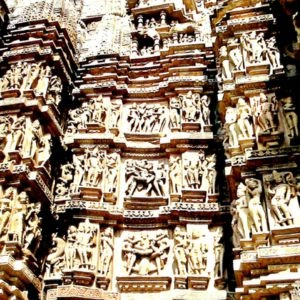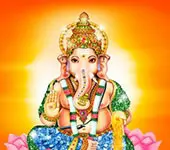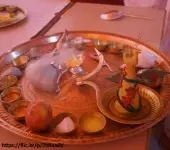A Glimpse into the 64 Arts

Sanatana Dharma has deeply ingrained views on the social, economic, and psychological well-being of human beings. These perspectives find expression in the sixty-four arts, documented in Sukraniti, Vatsyayana's Kamasutra, and the Agni Purana. This article explores the diverse facets of these arts, shedding light on their origins, significance, and enduring impact on contemporary industries and professions.
The 64 arts
- Geeta Vidya: Engaging in the art of singing.
- Vadya Vidya: Mastery of playing musical instruments.
- Nritya Vidya: Proficiency in the art of dancing.
- Natya Vidya: Theatrical skills and performance.
- Alekhya Vidya: Artistic expression through painting.
- Viseshakacchedya Vidya: Application of color to paint the face and body.
- Tandula-kusuma-bali-vikara: Crafting offerings using rice and flowers.
- Pushpastarana: Creating a bed covering adorned with flowers.
- Dasana-vasananga-raga: Skill in oral hygiene, dressing, and body adornment.
- Mani-bhumika-karma: Crafting intricate groundwork for jewels.
- Sayya-racana: Artful arrangement of the bed.
- Udaka Vadya: Playing music in water.
- Udaka-ghata: Splashing water skillfully.
- Citra-yoga: Practically applying a blend of colors.
- Malya-grathana-vikalpa: Designing intricate wreaths.
- Sekharapida-yojana: Skillful placement of a coronet on the head.
- Nepathya-yoga: Dressing behind the scenes in the tiring room.
- Karnapatra-bhanga: Ornamental decoration of the tragus of the ear.
- Sugandha-yukti: Practical application of aromatics.
- Bhushana-yojana: Skillful application and arrangement of ornaments.
- Aindra-jala: The art of juggling.
- Kaucumara: Engaging in a unique kind of art.
- Hasta-laghava: The dexterity of sleight of hand.
- Citra-sakapupa-bhakshya-vikara-kriya: Creating a variety of delicious foods.
- Panaka-rasa-ragasava-yojana: Crafting palatable drinks and adding red color to beverages.
- Suci-vaya-karma: Proficiency in needlework and weaving.
- Sutra-krida: Skill in playing with thread.
- Vina-damuraka-vadya: Playing the vina and a small two-headed drum.
- Prahelika: Crafting and solving riddles.
- Durvacaka-yoga: Practicing language that is challenging for others to answer.
- Pustaka-vacana: Reciting books.
- Natikakhyayika-darsana: Enacting short plays and anecdotes.
- Kavya-samasya-purana: Solving enigmatic verses.
- Pattika-vetra-bana-vikalpa: Designing shields, canes, and arrows.
- Tarku-karma: Engaging in spindle spinning.
- Takshana: Practicing carpentry.
- Vastu-vidya: Expertise in architecture.
- Raupya-ratna-pariksha: Testing silver and jewels.
- Dhatu-vada: Proficiency in metallurgy.
- Mani-raga jnana: Adding color to jewels.
- Akara jnana: Knowledge of mineralogy.
- Vrikshayur-veda-yoga: Practicing medicine or medical treatment using herbs.
- Mesha-kukkuta-lavaka-yuddha-vidhi: Understanding the fighting styles of lambs, cocks, and birds.
- Suka-sarika-prapalana (pralapana): Maintaining or understanding conversations between male and female cockatoos.
- Utsadana: Healing or cleansing a person with perfumes.
- Kesa-marjana-kausala: Skill in combing hair.
- Akshara-mushtika-kathana: Communicating using fingers.
- Dharana-matrika: The use of amulets.
- Desa-bhasha-jnana: Knowledge of provincial dialects.
- Nirmiti-jnana: Knowledge of predictions through heavenly voices.
- Yantra-matrika: Expertise in mechanics.
- Mlecchita-kutarka-vikalpa: Creating foreign or barbarous sophistry.
- Samvacya: Engaging in conversation.
- Manasi kavya-kriya: Engaging in flyting.
- Kriya-vikalpa: Designing literary works or medical remedies.
- Chalitaka-yoga: Practicing as a builder of shrines named after oneself.
- Abhidhana-kosha-cchando-jnana: Using lexicography and meters.
- Vastra-gopana: Concealing clothing.
- Dyuta-visesha: Understanding specific gambling techniques.
- Akarsha-krida: Playing with dice or magnets.
- Balaka-kridanaka: Crafting toys for children.
- Vainayiki Vidya: Enforcing discipline.
- Vaijayiki Vidya: Achieving victory.
- Vaitaliki Vidya: Awakening the master with music at dawn.
What is the significance of Geeta Vidya and Vadya Vidya among the 64 Arts?
Geeta Vidya involves the art of singing, while Vadya Vidya focuses on playing musical instruments. These arts hold cultural importance as they contribute to the expression of emotions and the creation of harmonious melodies, reflecting the profound connection between sound and human experience.
What is Utsadana practiced in the context of the 64 Arts?
Utsadana involves healing or cleansing a person with perfumes.
Quiz
Which ancient texts provide detailed mention and insights into the 64 Arts?Recommended for you
Krittika Nakshatra Famous Personalities

Guru Nanak - Spiritual Guru - Famous, preceptor. Bill Clinton - US President -Attractive personality, famous.....
Click here to know more..Vastu tips for your business place
 Click here to know more..
Click here to know more..
Ganesha Panchakshara Stotram

वक्रतुण्ड महाकाय सूर्यकोटिसमप्रभ। निर्विघ्नं कुरु मे द....
Click here to know more..
English Topics
Rare Topics
Click on any topic to open
- 237 The Practice of Bhojana Sadhana
- 236 Words of Wisdom - 2
- 235 Defining Goodness - Sanatana Dharma's Perspective
- 234 Vibhishana in Ramayana - A Tale of Morality, Loyalty, and Redemption
- 233 God will not let you break
- 232 A Glimpse into the 64 Arts
- 231 Chembai Vaidyanatha Bhagavatar - A Carnatic Maestro's Musical Odyssey
- 230 Understanding Adhyāsa: A Closer Look at False Attribution
- 229 Is Family's Permission Necessary For Becoming Sanyasi ?
- 228 Faith In Upasana
Please wait while the audio list loads..
30
Ganapathy
Shiva
Hanuman
Devi
Vishnu Sahasranama
Mahabharatam
Practical Wisdom
Yoga Vasishta
Vedas
Rituals
Rare Topics
Devi Mahatmyam
Glory of Venkatesha
Shani Mahatmya
Story of Sri Yantra
Rudram Explained
Atharva Sheersha
Sri Suktam
Kathopanishad
Ramayana
Mystique
Mantra Shastra
Bharat Matha
Bhagavatam
Astrology
Temples
Spiritual books
Purana Stories
Festivals
Sages and Saints
